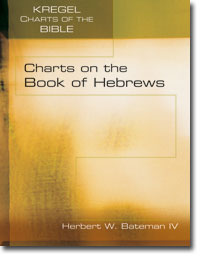Hebrews can be a hard book to grasp. Whether in Greek or English (or any other language), the development of the book’s logic–especially early on–requires careful attention. One hears about Jesus’ priesthood, which makes the most sense when examined against the backdrop of the Old Testament priesthood and sacrificial system. Angels and Moses and Aaron all make appearances, which are central to what the author of Hebrews says about Jesus. And then there is Melchizedek to reckon with!
Herbert W. Bateman IV, then, has a great idea in wanting to offer “information about Hebrews succinctly in visual format for today’s student and congregant.” He does this (effectively) with a book of charts, consisting in four major parts:
- Part 1: Introductory Considerations In Hebrews
- Part 2: Old Testament and Second Temple Influences In Hebrews
- Part 3: Theology In Hebrews
- Part 4: Exegetical Matters in Hebrews
Some charts are just one page (#87, “Positions on the Warning Passages in Hebrews”) or a few pages (#34, “Old Testament People Named in Hebrews”), while others are longer–nearly 10 pages of “Major Textual Issues in Hebrews” (#97) and nearly 20 pages of the (Greek) words that are unique to Hebrews (#103 and #104, listed both alphabetically and by chapter, respectively).
There is not much that this book leaves uncovered. Bateman covers the authorship and dating and genre questions thoroughly and succinctly. There are also helpful summaries of how various Hebrews commentaries have understood different aspects of the book. He explains and diagrams the tabernacle in the Old Testament, comparing it with its description in Hebrews (charts #35-#38).
Five pages on the not-well-known Melchizedek examine that figure in both biblical and extra-biblical context (Josephus, Dead Sea Scrolls, etc.). The theology charts found in the third part of Bateman’s book could easily be used in a congregational setting, especially the “Portraits of God” (#56) and Jesus (#57) in Hebrews. The final section looks in detail at Hebrews through interpretive, textual, rhetorical, and lexical lenses.
The “Chart Comments” at the back of the book add even more to the already substantive charts. A dozen-page bibliography concludes the work.
Here’s a sample chart:
And you can see here some comments on the first three charts, from the back of the book:
It’s remarkable how much ground Bateman covers in this appealing, visually organized medium. Seminary classroom teachers or church Sunday school teachers could make great use of these charts.
The one downside to this book, however, is that there is no accompanying CD-ROM or digital content. For a teacher to use a chart, she or he would have to copy from the book or scan in a chart for use in a class Powerpoint. A clean .jpg or .pdf file from the publisher would have eased this process for the user of this book. Hopefully future editions will come so equipped.
Though these charts are produced with a group in mind, any individual (with whatever level of knowledge about Hebrews) could benefit from using the charts for private or small group study. Even though these are charts, this is also the kind of book one could just sit down and go through. Bateman has provided a top-notch resource for an important biblical book.
Kregel sent me a copy of the book for review. Its product page is here, and it’s on Amazon here. The Table of Contents (which lists all the included charts) is here (pdf); read an excerpt here (pdf).




2 thoughts on “Charts on the Book of Hebrews, Reviewed”